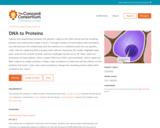
Students will participate in a 5E lesson. To ENGAGE, students will connect their understanding of similarities between parent and offspring to the fundamental molecule of life: DNA. To EXPLORE, students will participate in interactives to observe, analyze and summarize how genes are used to create proteins and traits. In the EXPLAIN section, students will take notes on DNA replication and the Central Dogma. To ELABORATE on their understanding of DNA, students will participate in a protein synthesis race (game) to practice transcription and translation. Formative evaluations of students's ability to explain the process of protein synthesis include (1) a protein synthesis and codon practice sheet, (2) a labeling activity, and (3) making a recording that models and explain the process. As an extension, students can apply their understanding of mRNA to explain how the Pfizer and Moderna COVID-19 vaccines work. Finally, int summative EVALUATE, students model replication, transcription, and translation as they build an organism!
- Subject:
- Health and Medical Sciences
- Living Systems and Processes
- Science
- Scientific and Engineering Practices
- Material Type:
- Activity/Lab
- Assessment
- Homework/Assignment
- Lecture Notes
- Author:
- Mary Hill
- Date Added:
- 02/12/2021
